Get to the heart of what motivates your audience and customers to buy and why it matters.
How can you help your business stand out in today's noisy and crowded business environment? How can you find new tools that increase growth, profit, and customer loyalty? Consider making emotional connection the overarching goal of every stage in your customer journey.
Value of Emotional Connection
We all have brands we feel a personal connection with. Their stories deeply connect meaning to their message in ways that ring true in our lives. They resonate with us and we identify with them. Does this emotional connection translate to real business results?
Brands that develop strong emotional bonds with their target audience and customers find increased loyalty, sales and often exponential growth. Emotions powerfully, and persuasively influence decision making. Notably, when we connect emotion with the choice at hand we can see how they influence buying behavior. A buyer anxious about the results of a choice may choose a safer option instead of one with greater financial growth.
A Harvard study found emotionally connected customers were twice as valuable to companies as highly satisfied customers. Here are some characteristics of emotionally engaged customers that contribute to their value. It’s everything you hope their experience with your company would motivate them to do.

A crucial driver of emotional connection is the customer experience. How you communicate, interact and engage with prospects and customers matters. The research also shows us that 50% of an experience is based on emotions.
Although we attempt to make entirely rational decisions, we are driven by emotional motivations. Every interaction a person has across the customer journey contributes to this connection. They become increasingly convinced “this company gets me”.
When one financial firm put to work activities that increased emotional connection they saw surprising business results. Emotionally connected customers were 6 times more likely to move assets to their company than only satisfied customers. This impacted profit in significant ways.
The greatest brands connect their functional benefits with relevant emotional benefits, like feeling secure or having confidence in the future. This study identified that doing so delivers +52% in value versus just providing customer satisfaction.
When companies develop emotional connection strategies and metrics to measure customer experience, they find a powerful way to increase customer value. They see a return on investment decisions and increased profits.
How Emotion Impacts Decision to Buy for B2B companies
Customers with strong connections to B2B companies have higher rates for consideration, purchase, and willingness to pay a premium.
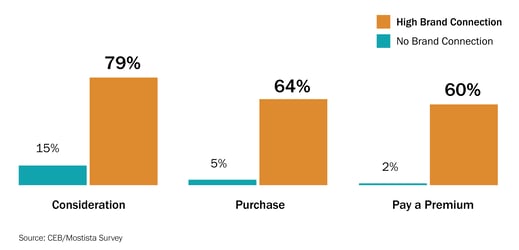
Brand benefits critical to understanding purchase decisions for B2B companies include two categories.
Functional benefits: These appeal to reason and logic around the functional job your product or service does. They generate business value like the ability to achieve business goals and outcomes etc. In the purchasing process, these benefits give your company a seat at the consideration table.
Emotional benefits: These appeal to professional, social and emotional benefits. They build personal value for people in ways like career advancement, popularity, admiration from others, confidence, feeling accomplished, and self-image
The Marketing Leadership Council partnered with Google to research the effect emotional and functional benefit categories had on business outcomes. These included consideration, purchase, premium payment, and advocacy.
The data showed that personal value (emotional benefits) has twice as much impact as business value (functional benefits). When you consider that business purchases can involve enormous risks like losing credibility, time, and jobs, this makes sense.

Individuals involved in the decision to buy need to feel confident your brand can add value and eliminate personal risk. It makes sense then that business customers require a significantly greater emotional connection to help them overcome the risk. In fact, the greater the perceived personal risks (losing credibility, time, job), the more emotional connection is needed.
Emotions do matter even more than logic/reason. This opens opportunities for marketing to position brands around personal value or emotional benefits.
Business value gets a supplier into the buyer’s consideration set
Brands need solutions that offer both business value and personal value to influence buyer behavior.
Consumers who believe a brand will provide business value are 4x likely to consider that brand. However, demonstrating business value has limitations when it comes to a customer’s willingness to pay a premium. It turns out that only 14% of buyers recognized enough meaningful difference to be willing to pay for it.
Most of us are well aware of the ensuing scenario where a customer does his research to solve his problem. He identifies companies that all provide business value and brings them to the consideration table. Since each supplier's perceived business value is the same, the supplier is selected on price.
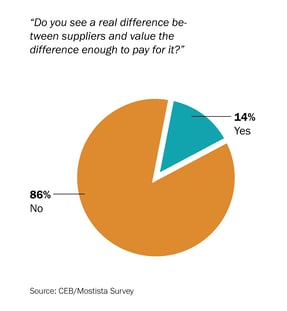
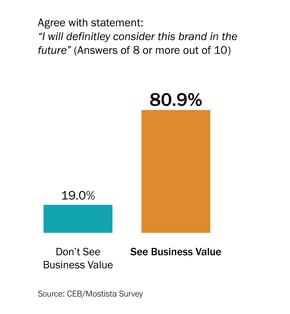
How do brands move from a buying decision process focused on price to one of unique value? Let’s look at the combination of personal value and business value.
Personal Value Wins Over Business Value
For B2C brands studied by Motista most had emotional connections with their customers between 10% and 40 %. Significantly, for B2B brands, more than three quarters studied surpassed the 50% mark. B2B brands that connect with their buyers on an emotional level saw a 2 times increase in revenue growth when compared with brands only selling on functional value.
Not surprisingly, B2B buying involves more personal risks. B2B stakeholders fear loss of time, effort, credibility, and job if a purchase decision goes poorly. The more risk a purchase requires, the greater strength of emotional connection is needed to overcome the risk. This results in a high emotional connection among existing customers.
When you look at the effect personal value plays in purchase decisions for non-customers, the impact becomes clearer. Non-customers, who don’t see the personal value, are less likely to purchase. In addition, they are7 times less likely to pay a premium.
An opportunity to help non-customers understand the personal value of your business comes as you connect on a human level. This presents a pathway for brands to grow in significant ways.
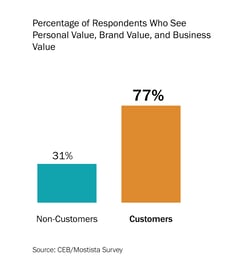
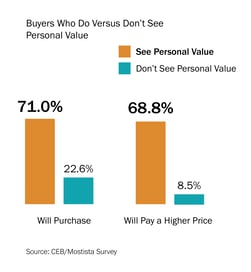
Combine business insights with emotional motivators to set them apart
-
Teach customers something unexpected and new about their own business needs and challenges that leads back to you.
-
Provide customers with a compelling reason why it is necessary to take action.
-
Understand customer’s personal goals and emotions.
-
Create brand messaging that convey personal value and drive action at every stage of the buyer’s journey.
-
Put your emotional motivators to work for you and let them help you move satisfied customers up to full emotional connection.
How to put emotional connections to work for your brand
Be precise about the emotional connections you are trying to build. Seek motivators that best predict purchase behavior. Begin by looking at your best customers.
This is your high value customer. Those who buy and advocate the most, shop more often, are less-price sensitive, and most loyal.
Then compare the emotional motivators of your best customers with the overall customer base. Identify which ones are specific to or more important to the high-value group. These key motivators are your guide to how you need to connect with your most valuable customers and grow the segment.
Now that you know what they are, develop and invest in touch points that drive these connections. Emotional motivators vary by category, customer segments and buyer’s position in the buyer’s journey.
So make sure you look for growth opportunities taking place throughout the experience. Make sure and build emotional connections at every stage. Finally, look for opportunities to move satisfied customers up to full emotional connection.



